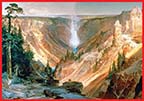American Issues  Connector: Interaction With the Environment
Connector: Interaction With the Environment

A herd of caribou grazes on a plain near an oil-drilling facility in Alaska.
TRACK THE ISSUE
![]() How can we balance economic development and environmental protection?
How can we balance economic development and environmental protection?
The goals of economic growth and environmental protection are often in conflict. For example, power plants provide energy, but they pollute the air. Dams supply water, but they destroy natural habitats. Finding a balance between growth and conservation may involve trade-offs. Use the timeline below to explore this enduring issue.
-
1872 Yellowstone
First national park is established.
-
1916 National Park Service
Congress creates the National Park System.
-
1962 Silent Spring
Rachel Carson’s book exposes dangers of pesticides.
-
1970 Clean Air Act
Congress establishes air quality standards.
-
1973 Endangered Species Act
Law offers protection for threatened species.
-
1997 Kyoto Protocol
United States signs international agreement on CO2 emissions, but Congress fails to ratify it.

A view of Yellowstone’s Grand Canyon painted in 1872
DEBATE THE ISSUE
The Search for Oil Alaska’s Arctic National Wildlife Refuge (ANWR) is a large nature preserve with an abundance of wildlife. It may also contain large deposits of crude oil. Some people want to drill for this oil, while others believe oil drilling would ruin the pristine wilderness.
“… There are good reasons … to permit ANWR drilling…. It could be done without wrecking the environment…. Only 2,000 acres of the 19 million-acre ANWR refuge would be subject to drilling…. Drilling could create 250,000 to 735,000 jobs nationwide…. [Drilling] in an environmentally sensitive fashion is important insurance against future energy shocks.”
—Editorial, USA Today, 2005
“Drilling in the Arctic Refuge is not a path to energy independence or lower prices at the pump. The United States Geological Survey estimates that the Refuge has less than a single year’s supply of oil that would not reach the market for at least 10 years. Meanwhile, the harm to wildlife and to our greatest wildlife refuge would be irreparable.”
—Defenders of Wildlife
 TRANSFER Activities
TRANSFER Activities
- Compare Why does the first source support drilling in the arctic refuge? Why does Defenders of Wildlife oppose it?
- Analyze How might the first source have responded to the creation of the National Park Service in 1916? Explain.
- Transfer Use the following Web site to see a video, try a WebQuest, and write in your journal. Web Code: neh-9002




